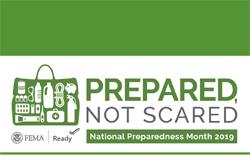September is National Preparedness Month and a great time to develop an emergency/disaster plan. Family members may not be together when a disaster occurs, so be sure to make plans for everyone to be in a place for them to contact and find each other. A location to meet away from your home should be chosen and all family members should be aware of the location and how to get there.
Practice evacuating your home twice each year. Drive your evacuation route and plot alternate routes on your map in case roads are impassable. Families should designate an out-of-area emergency contact person and each member should keep the contact information with them at all times.
If an emergency occurs while all family members are in the home, a place right outside the home such as the front sidewalk or a neighbor’s yard should be chosen.
Have proper supplies in case of an emergency or disaster and store in an easy-to-carry emergency kit that you can use at home or take with you if you must evacuate.
At a minimum, have these basic supplies:
- Water—one gallon per person, per day (3-day supply for evacuation, 2-week supply for home)
- Food—non-perishable, easy-to-prepare (3-day supply for evacuation, 2-week supply for home)
- Flashlight
- Battery-powered or hand-crank radio (NOAA Weather Radio, if possible)
- Extra batteries
- First aid kit
- Medications (7-day supply) and medical supplies (hearing aids with extra batteries, glasses, contact lenses, syringes, etc.)
- Multipurpose tool
- Baby supplies (bottles, formula, baby food, diapers)
- Games and activities for children
- Pet supplies (collar, leash, ID, food, carrier, bowl)
- Two-way radios
- Extra set of car and house keys
- Manual can opener
- Personal hygiene items
- Copies of personal documents (medication list and pertinent medical information, proof of address, deed/lease to home, passports, birth certificates, insurance policies)
- Cellphone with charger
- Family and emergency contact information
- Extra cash
- Emergency blankets, sleeping bags
- Fire extinguisher
- Paper/pencil
- Mess kits, paper cups, plates, paper towels and plastic utensils
- Map(s) of the area
Additional items to keep at home or in survival kit based on disasters common to the area:
- Whistle
- N95 or surgical masks
- Matches in a waterproof container
- Rain gear
- Towels
- Work gloves
- Tools/supplies for securing your home
- Extra clothing, hat and sturdy shoes
- Plastic sheeting
- Duct tape
- Scissors
- Household liquid bleach
Know likely emergencies for your area:
Learn the types of disasters or emergencies that may occur in your area. These events can range from those affecting only you and your family, like a home fire or medical emergency, to those affecting the entire community, like an earthquake or flood.
- Identify how local authorities will notify you during a disaster and how you will get information, whether through local radio, TV or NOAA Weather Radio stations or channels.
- Know the difference between different weather alerts such as watches and warnings and what actions to take in each.
- Make sure that at least one member of your household is trained in first aid and CPR and knows how to use an automated external defibrillator (AED).
- Share what you’ve learned about preparedness with family and neighbors.
First aid kit items for a family of four:
- 2 absorbent compress dressings (5 x 9 inches)
- 25 adhesive bandages (assorted sizes)
- 1 adhesive cloth tape (10 yards x 1 inch)
- 5 antibiotic ointment packets (approximately 1 gram)
- 5 antiseptic wipe packets
- 2 packets of aspirin (81 mg each)
- 1 blanket (space blanket)
- 1 breathing barrier (with one-way valve)
- 1 instant cold compress
- 2 pairs of non-latex gloves (size: large)
- 2 hydrocortisone ointment packets (approximately 1 gram each)
- Scissors
- 2 roller bandages 3 inches wide and 4 inches wide
- 5 each sterile gauze pads 3 x 3 inches and 4 x 4 inches
- Oral thermometer (non-mercury/nonglass)
- 2 triangular bandages
- Tweezers
- First aid instruction booklet
- Items such as medications, emergency phone numbers
Keep a first aid kit in your home and in your car and check them regularly. Check expiration dates and replace out-of-date contents. Also, ensure that the flashlight batteries work.
Sources: www.ready.gov and www.redcross.org


